#cluboftheyear – The Mitsubishi Motors "Sailing Club of the Year" for 2014 will be announced tonight. W M Nixon looks back on a unique inter-club contest with which he has been involved since its inception 35 years ago, and reflects on a challenge to the Royal Cork's position of historic significance as the oldest yacht club in the world.
Is the Royal Cork Yacht Club, descended directly from the Water Club of the Harbour of Cork with its establishment in 1720, really and truly the oldest yacht club in the world? The nautical blogosphere and its comments departments have been busy of late, as folk became exercised about the "new" discovery that the Squadron of the Neva, a potential rival claimant in Imperial Russia, was founded two years earlier in 1718.
We've been here before, thanks to the Mitsubishi Motors "Sailing Club of the Year". This informal contest, completely unique when it first appeared in 1979, has long since become an accepted part of Irish sailing. It has served several useful purposes in that it has more clearly analysed what it is that makes the best of Ireland's remarkably successful yacht and sailing clubs tick, it has given us a template for club development and fulfilment, and it has provided a complete record of an important part of Irish sailing history simply because we now have a list of the many winners going back 35 years.
It started in the weirdest way. Sean O'Shea, a good old-fashioned Dublin PR man, was in his car in a traffic jam outside an antique shop in the city centre in 1978, and while stopped he ran his eye over the items on display, which included a ship's wheel. It was quite some traffic jam, for by the time he was moving along again, his busy brain was developing the notion of using the old wheel as a trophy in sailing. When he'd finally reached his destination, he'd decided that it should be some sort of trophy for sailing which would have the unique feature of somehow being awarded to people who personally might not have actually won some sailing race or other.
In those distant days, all of Ireland's national newspapers (all three of them) carried weekly columns on sailing, acres of newsprint with regular photo usage. I wrote the one for the Irish Independent, so he cast a fly over me as to how this "awarding everyone" concept might best be done, for he could see PR opportunities for one of his client companies in it. We kicked some ideas around (in a classic Dublin pub of course, Sean was a connoisseur of Guinness) and somehow the notion – utterly crazy at the time - emerged of a Club of the Year contest.
Back in 1979, if there was such a contest anywhere else in the world, we didn't know of it. So I went home and bashed out the defining characteristics of a successful sailing club on the little Olivetti typewriter (I produced so much verbiage in those days that a new Olivetti every 18 months was an essential), and soon discovered that there was a lot more to the successful clubs than staging popular and stylish events and having members who won major championships.
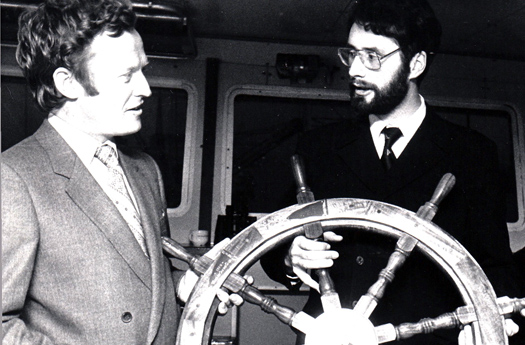
The 1980 winner was Malahide YC, and the presentation was a two part ceremony, with the ship's wheel being presented aboard a ship in Dublin port, while the celebration took place in MYC's new clubhouse. Photo shows Frank Cormican (left) of original sponsors Coal Distributors, and MYC Commodore Peter Killen aboard the ship. Peter Killen became the Commodore of the Irish Cruising Club on February 14th 2014.
There was the requirement of having good and pro-active relations within the community of which they were part, which was an odd enough idea in 1979, when most clubs seemed aloof, or at the very least self-absorbed. There was of course the obvious requirement of encouraging newcomers to the sport, while having the good sense to know who would be worthwhile sailors and members, and who would not. There was the cultivation of good use of the media, limited and all as it was in those days. There was the need to foster junior development and sail training programmes for all ages. And most important of all, there was the need to have catered for your members' needs, to have brought them along with you in enthusiastic support of new projects, and to have maintained and developed that spirit of volunteerism within the membership which is the essence of the good Irish sailing club.
While "community" may be an over-used word these days, back in 1979 the idea of applying it to a yacht club was still a novel notion, but we decided we'd try to see how the concept of community manifested itself within the clubs which were emerging at the front line of this new informal contest. In the form in which the Club of the Year competition was to emerge after six years of growth, the system which proved to work best was when we simply included all the 120 clubs in Ireland in it – there was no need for any formal entry, as we reckoned the club staff of those days, most of them voluntary, had quite enough to be doing without having to fill out yet another lot of forms.
A small panel of adjudicators was established, and they only emerged (and even then only if they wished - some preferred to remain anonymous) at the award ceremony. The idea was to cover the country, but under the radar. The adjudicators were active in sailing, and between us we were directly engaged with virtually all of the clubs in the country in any one year. But this adjudication was not done on official visits. On the contrary, the idea that clubs would be aware that they were being assessed at any particular time was anathema to the central notion that it was the club's primary duty to serve their own membership, and you could do this best by managing to have a visit more or less unnoticed, as part of a crowd of participants in some sailing event, or as the attendance at a social gathering, or - sometimes best of all - simply under the guise of a visitor from another club hoping to enjoy the fraternal hospitality of the club being scrutinised. This was how it all gradually developed, but it took time for the requirements for a successful inter-club competition to emerge.
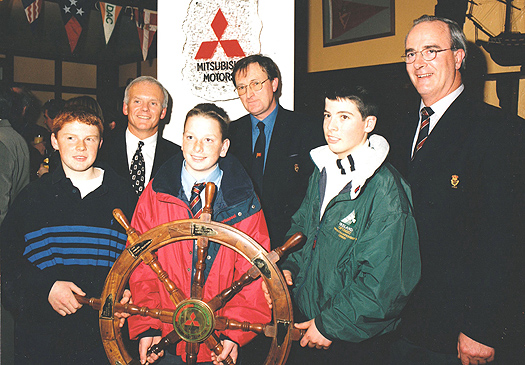
The ground-breaking presentation to the Royal Cork YC for 1992's great season. In the background are Eugene O'Reilly (Mitsubishi Motors) outgoing Admiral Kevin Lane, and incoming Admiral Anthony O'Leary. Twenty-one years down the line, how has it been going for the junior sailors in the foreground? Photo: Bob Bateman
Back in the late 1970s, Irish sailing was a much less vigorous creature than it subsequently became, and the affluence of the country was at a very low level. For the first few years, the sponsor, drawn from Sean O'Shea's decidedly eclectic portfolio, was a conglomerate in the coal importing business. In retrospect, that feels only marginally better than a tobacco company. But they wanted to give themselves a fresher image, we had the vehicle, and the show was on the road.
The first winners in 1979 were Wicklow Sailing Club, who had broadened their scope that year with a family cruising rally initiative. When you consider that in 1980 they inaugurated the Round Ireland Race, it gives you some notion of how quiet the sailing innovation scene was in the 1970s. Back then, the hottest show on the sea throughout the decade was the annual programme of the Irish Sea Offshore Racing Association, which at its peak attracted 107 boats to its annual season-long championship.
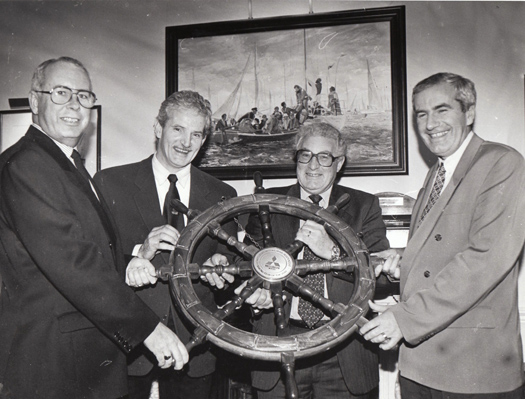
1993 saw the first dual award, to the National YC of Dun Laoghaire and the St Brendan Sailing Club of Dingle for the successful introduction of the Dun Laoghaire to Dingle Race. At the presentation were (left to right) Brian Barry (NYC Commodore), John O'Connor (Dingle commodore), Frank Keane, Chairman of Mitsubishi Motors, and Barry Rose. As Commodore of ICRA, Barry Rose was himself a winner in 2011 to honour Ireland's 2010 Commodore's Cup victory.
The first awards ceremony was a very low key affair at a small reception in the Gresham Hotel. But by the following year, there came an increased awareness that merely handing out the ship's wheel trophy at a Dublin city centre venue to facilitate the press simply wasn't good enough. Every successful club is at the heart of its own universe, however small, so the only proper way to honour the winning club is with an award ceremony in its premises, which has the additional benefit of making a useful injection into bar and catering turnover.
So in 1980, there was a compromise. The winners were Malahide YC for managing to build their very attractive new clubhouse despite the Irish economy being in its default mode of contraction. But the coal company felt there should be some gesture towards who they were. So one half of the ceremony took place on board a huge bulk carrier unloading coal in Dublin docks, and then everyone – led by those Malahide stalwarts Sam Dix and Jock Smith – went haring up the road to Malahide to celebrate it all in the lovely new clubhouse with very considerable exuberance.
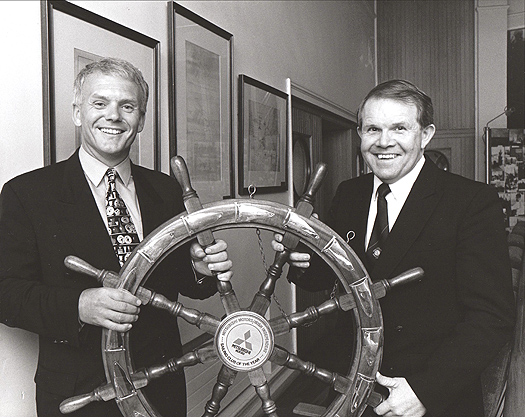
1995 was Howth YC's Centenary, which was brilliantly celebrated to make them Club of the Year. With the ship's wheel are Eugene O'Reilly of Mitsubishi Motors, and HYC Commodore David Lovegrove
For the first six years, the competition was restricted to clubs on the Leinster east coast, as that was the area covered (in every sense) by the coal company. But in the mid-1980s Frank Keane, that extraordinary bundle of energy and innovation in the motor business, decided that he needed to balance his extremely successful BMW distributorship with a Japanese model aimed at a different segment of the market. So he took on Mitsubishi Motors just as they were launching vehicles which might have been made for Irish roads such as the Pajero. As he was another of Sean O'Shea's clients, in very quick order the Club of the Year award acquired an excellent and enthusiastic sponsor, and it went national.
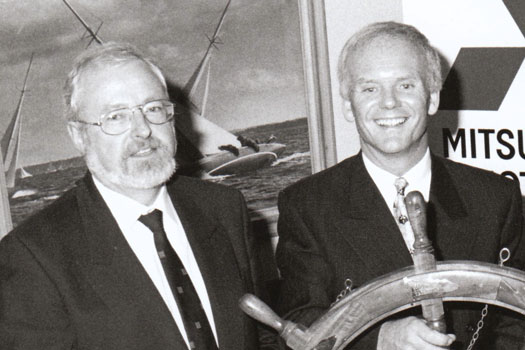
To honour a remarkably successful season achieved in 1997, Kinsale YC were Club of the Year for 1998. Commodore Pat Pyne accepts the trophy from Eugene O'Reilly.
Becoming an all-Ireland thing with 120 clubs under consideration was a quantum leap, but when you find yourself being encouraged by the top people in the motor business, you're in a different league. They're as tough as old boots, yet utterly human and thoughtful underneath it all. It's difficult to tell sometimes if it's delight in business or shared joy in good cars which motivates them, but it was an eye-opener for the rest of us as the Club of the Year trophy went to all parts of Ireland.
In every corner of the country, however remote, Frank Keane would have as a guest some old customer who'd bought one of the very first BMWs from him many years earlier, and had bought several ever since, some of them on an annual basis not because the cars wore out, but because he was such a pleasure to do business with.
But it was a while before we settled into this successful pattern, and for the first year with Mitsubishi Motors, the ceremony was in the Dublin area in any case, with Howth YC being the 1986 winners, neatly timed as the awards ceremony was one of the first events in their startling new clubhouse in April 1987.
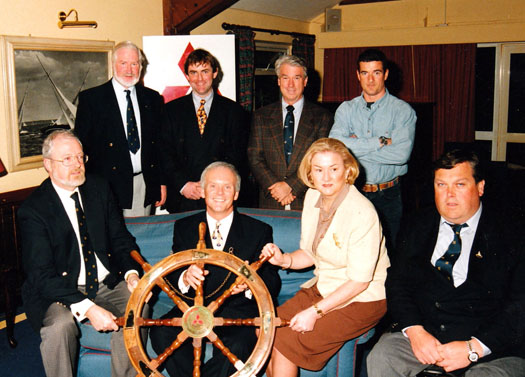
Kinsale sailors with their trophy in April 1998. Front row includes KYC Commodore Pat Pyne (left), Eugene O'Reilly (centre) and John Twomey, now President of International Federation for Disabled Sailing (right), while on the right in the back row are international yacht designer Ron Holland, and Figaro skipper Damian Foxall, who sailed under the Kinsale burgee.
But through 1987, one club was to be head and shoulders above all others. The Royal Cork, oldest yacht club in the world dating from 1720, was on one of its frequent sprints, achieving in all areas. Yet around that time, yachting historian Hal Sisk was voicing his reservations about Royal Cork being the world's most senior club, pointing out that it was absolutely definite that an organisation called the Squadron of the Neva had been established in Russia by Czar Peter the Great in St Petersburg in 1718 with the express purpose of encouraging the sons of the aristocracy to take up recreational boating.
It was an interesting point, and it had to be addressed. So when at year's end the Royal Cork were announced as the Club of the Year (and they've now won it five times in all), somehow a crazy idea arose. We wouldn't go all the way down to Crosshaven to present them with the trophy. At the best of times, it was a tricky proposition for Mitsubishi Motors and the Irish Independent alike, as it would have taken us into the heart of Ford territory and Cork Examiner land. But instead, we'd see if we couldn't arrange to have the presentation in the Russian Embassy in order to acknowledge our awareness of the claims of the Squadron of the Neva, while highlighting the magnificent achievements in 1987 by the Royal Cork YC.
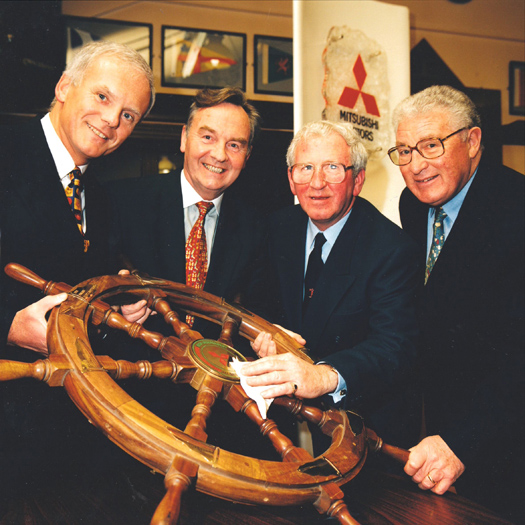
1998 saw the Tall Ships visit Dublin in large numbers, and volunteers from all over Ireland converged on the port to assist in the massive logistics support operation afloat in the harbour. Poolbeg Yacht & Boat Club in Ringsend was the focal point for his superb exercise in co-operation, and it was celebrated by PY&BC becoming Club of the Year for 1999. At the award ceremony are (left to right) Eugene O'Reilly (MD Mitsubishi Motors), Minister for the Marine Dr Michael Woods TD, James O'Donnell (Commodore, PY & BC) and Frank Keane (Chairman, Mitsubishi Motors).
This was to be done in the early Spring of 1988. It was a tricky proposition. Although Perestroika and Glasnost were becoming evident, the Berlin Wall wasn't to fall until 1989. The Soviet Union may have been creaking and rattling more than somewhat, but the fine house in Dublin's elite ambassadorial belt was still very much the embassy of the USSR – the Union of Soviet Socialist Republics. Calling it the Russian Embassy was getting ahead of the game. This was the eastern bloc's headquarters in Dublin, with the Cold War still very much with us, and no mistake.
Yet they agreed to host the party. So now we'd equally tricky negotiations. Would the Royal Cork YC agree to come to Dublin on such a bizarre mission? God bless them, they came in force. We had the makings of the most unusual party ever staged in Irish sailing.
Our host was the Soviet ambassador himself. If in the 1980s you'd asked for Central Casting to send you an actor to personify the popular conception of a Soviet diplomat, they'd have sent you Gennady Uranov. Though he was qualified as an engineer, in the continuous turmoil and unexpected outcomes of Russian and Soviet history, somehow he'd ended up in the diplomatic service and done comfortably well, as the embassy in Ireland was a very agreeable posting. Fairly heavily built but in trim shape, with well-tamed strong grey hair, the ambassador had presence, with charm and an occasional sense of humour. Nevertheless he was very much on his guard, as this was an unusual event, indeed an unprecedented one, and with turmoil back home the embassy people weren't a hundred per cent certain, for all that they'd got approval from headquarters as to how their actions would be interpreted back in Moscow, let alone who would be doing the interpreting.
Meanwhile, we'd our own little drama to play out. As part of the evening's programme, Hal Sisk outlined in detail the Squadron of the Neva's claims to seniority. It has to be admitted that the faces of the Royal Cork group were not those of happy budgies. Nevertheless they manned up and accepted the ship's wheel trophy with good grace, pleasantries were exchanged between all parties with the ambassador being a sort of amiable Russian bear in the midst of it all, and then I'd to deliver the adjudicators' reasons for the Royal Cork being the Club of the Year.
It was soon done, but the moment was too good to miss. As we'd everyone relevant there, the opportunity to blow the Squadron of the Neva's claims of seniority clear out of the water was taken with enthusiasm. The point was made that the Water Club of the Harbour of Cork established precedents for what a sailing club should be, right from the very start. The first Admiral may have been Lord Inchiquin of Rostellan Castle on Cork Harbour, but his fellow members, while they may have been rich – very rich by Irish standards – were "commoners", joined together in a self-starting society of mutual support and agreement in order to express a shared interest and pleasure in sailing, and adhering to a collection of self-generated club rules which were so effective that many of them are still relevant today, with the rules of Water Club having a contemporary feel despite the fact that they were codified by equals back in the middle of the 17th Century.
The Squadron of the Neva, on the contrary, wasn't a club at all. It was a small unit of the Imperial Russian Navy, imposed by the diktat of an omnipotent Czar who wanted to make his governing classes more sea-minded. There is simply no comparison with the Water Club, which has provided the template for democratic sailing clubs ever since. But the rigid structure of the Russian organisation was something else altogether, and is only of relevance in how to organise a navy, or more accurately – judging by the outcome of the Russian-Japanese War of 1904 – how not to organise a navy.
That historical point having been clarified to the approval of the Royal Cork, the Mitsubishi Motors "Sailing Club of the Year" took off at national level, and when the Royal Cork won it again in 1992, there was no hesitation in venturing into the Indian territory of Fordland and Cork Examiner country for the award ceremony, with the Crosshaven clubhouse's flagpole dressed overall in April 1993 for a monumental party.
Anthony O'Leary had just been elected Admiral, but his predecessor in 1991 and 1992 had been Kevin Lane, whose acceptance speech was distinctly thought-provoking for those of us who might have been treating the Club of the Year business in a light-hearted way. Kevin Lane spoke briefly but forcefully. He said quite clearly that when he became Admiral in advance of the 1991 season, he called his top sub-committee chairmen together, and told them that that the underlying thread of his two years in office would be to fulfil a programme afloat and ashore so through and enthusiastic that there would be no doubt by the Autumn of 1992 that Royal Cork was going to be the new Club of the Year.
The adjudication panel were astonished and silenced for a little while, for we'd known nothing of the Admiral's mission statement in 1991. This was awesome stuff. But with the Royal Cork setting the standard in 1992, and having set the standards back in 1720, the ship's wheel trophy was now part of Irish sailing heritage, and so it has remained ever since, with tonight's announcement being followed in due course by a handover ceremony at the winning club as the new season gets under way.
But as we get this glimpse of the future, spare a thought for those who were there in the Soviet Embassy back in 1988. One outcome was that an unlikely friendship was struck up between Eugene O'Reilly, Financial Controller and later MD of Mitsubishi Motors Ireland, and Ambassador Gennady Uranov. It became more than an exchange of pleasantries and letters. Eugene and his family went to stay with Gennady and his family in Russia, and holidayed with them. The Irishman was disconcerted to find that, in addition to his diplomatic role, his host was a Colonel in the Russian secret service, the KGB. Not to worry, said Gennady, everyone who's anyone in Russia is a Colonel in the KGB – it's like a sort of combination of the Freemasons and the Knights of Columbanus.
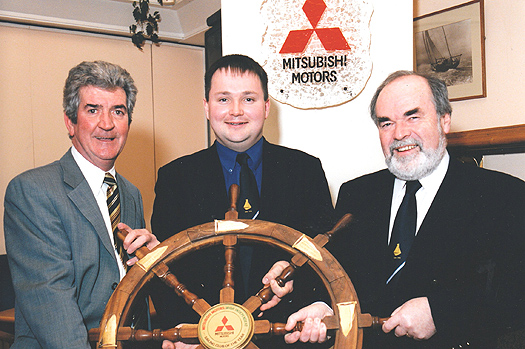
With the new Millennium, the competition was expanded to include Class Associations, and subsequent winners have included the Shannon One Design Association. In 2001, the winner was Ireland's (and the world's) oldest One Design keelboat class, the Howth 17s, established 1898. The trophy was presented to incoming Class Captain Marcus Lynch (centre) by Paddy Murphy (left), Marketing Manager, Mitsubishi Motors, with Frank Cruise, outgoing Captain Howth 17 Class Association.
Alas, whichever branch of this secretive organisation he was in, the former ambassador to Ireland proved to be on the wrong side of the rapidly-changing new developments in Russia. He was dropped from the diplomatic service, and sent to the salt mines. That's not quite as dreadful as it sounds. With his qualifications, he became a senior engineer in Russia's vast salt mines. Many would have regarded it as a plum job. But for someone who'd fitted comfortably into life on the Dublin diplomatic circuit and had quietly relished hosting the occasional unusual party for sailing weirdos who used his hospitality to dispute obscure points of history, it must have been grim.
And who knows, but perhaps something which came out of Gennady Uranov's introduction to the Irish sailing community may have hastened his downfall. For he was so taken with it all that he arranged for his two sons to be enlisted in the Royal St George Yacht Club junior training programme in Dun Laoghaire. Quite what the founders of the George – Anglican Ascendancy establishment figures to a man – would have made of their successors accommodating the children of the senior agent in Ireland of Godless atheistic communism heaven only knows, yet it happened.
So perhaps his downfall came about because someone in the Kremlin spotted a celebrated headline which was splashed across an Irish tabloid when an ace reporter discovered that the Russian ambassador's sons were going yachting.
RED SONS IN THE SAIL SET, it said. It may have delighted Dublin journalists, not least in that the song Red Sails in the Sunset was written by Irishman Jimmy Kennedy. But it can't have pleased the heirs of old Joe Stalin.
































































